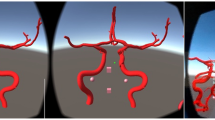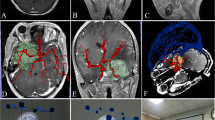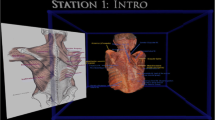Abstract
Purpose
To analyze the effectiveness of incorporating virtual reality (VR) in lectures on esophageal and mediastinal anatomy and surgical procedures for medical students at Gifu University during clinical training.
Methods
We divided medical students participating in clinical training, randomly, into two groups of 30 students each: those who received a lecture using 3D images (3D group) and those who received a lecture using VR images (VR group). Four days after the lecture, the students completed a written test to allow us to evaluate their comprehension, and a questionnaire on their opinion of the lectures.
Results
Based on the results of the written test, the VR group achieved better understanding of computed tomography (CT) images (p = 0.0001) and better interpretation of surgical images (p = 0.0163). However, there was no difference in the scores for spatial recognition and general problems. The questionnaire revealed that the VR group became more interested in mediastinal anatomy (p = 0.0165) and surgery (p = 0.0135).
Conclusions
Our findings suggest that VR enhances the learning process. The lecture incorporating the VR experience was more effective than the traditional lecture for promoting an understanding of CT images and interpretation of surgical images; thus, it enhances the learning experience for medical students studying surgery.

Similar content being viewed by others
References
Ito K, Sugimoto M, Tsunoyama T, Nagao T, Kondo H, Nakazawa K, et al. A trauma patient care simulation using extended reality technology in the hybrid emergency room system. J Trauma Acute Care Surg. 2021;90:108–12.
Aoki T, Koizumi T, Sugimoto M, Murakami M. Holography-guided percutaneous puncture technique for selective near-infrared fluorescence-guided laparoscopic liver resection using mixed-reality wearable spatial computer. Surg Oncol. 2020;35:476–7.
Kitagawa M, Sugimoto M, Umezawa A, Kurokawa Y. Clinical benefit of mixed reality holographic cholecystectomy. In: Takenoshita S, Yasuhara H, editors. Surgery and operating room innovation. Tokyo: Springer; 2020. p. 107–12.
Giuseppe Q, Alfonso L, Luc S, Muhammad S, Alexandre H, Toby C, et al. Virtual and augmented reality in oncologic liver surgery. Surg Oncol Clin N Am. 2019;28:31–44.
Bartella AK, Kamal M, Scholl I, Schiffer S, Steegmann J, Ketelsen D, et al. Virtual reality in preoperative imaging in maxillofacial surgery: implementation of “the next level”? Br J Oral Maxillofac Surg. 2019;57:644–8.
Samer ZA, Ralf S, Ivo F, Heinz WS, Ioanna S, Murat Y, et al. Virtual reality-based evaluation of surgical planning and outcome of monosegmental, unilateral cervical foraminal stenosis. World Neurosurg. 2019;123:e857–65.
Sinitsky DM, Fernando B, Potts H, Panagis L, George H, Pasquale B. Development of a structured virtual reality curriculum for laparoscopic appendicectomy. Am J Surg. 2020;219:613–21.
Domenico V, Giovanni C, Juan GR, Nicola M, Bhaskar KS. VR and machine learning: novel pathways in surgical hands-on training. Curr Opin Urol. 2020;30:817–22.
Barré J, Michelet D, Truchot J, Jolivet E, Recanzone T, Stiti S, et al. Virtual reality single-port sleeve gastrectomy training decreases physical and mental workload in novice surgeons: an exploratory study. Obes Surg. 2019;29:1309–16.
Medhat A, Greg RW, Tan A. Virtual reality training in laparoscopic surgery: a systematic review and meta-analysis. Int J surg. 2016;29:85–94.
Aïm F, Lonjon G, Hannouche D, Nizard R. Effectiveness of virtual reality training in orthopedic surgery. Arthroscopy. 2016;32:224–32.
Sato Y, Sugimoto M, Tanaka Y, Suetsugu T, Imai T, Hatanaka Y, et al. Holographic image-guided thoracoscopic surgery: possibility of usefulness for esophageal cancer patients with abnormal artery. Esophagus. 2020;17:508–11.
Jingjie Z, Xinliang X, Hualin J, Yi D. The effectiveness of virtual reality-based technology on anatomy teaching: a meta-analysis of randomized controlled studies. BMC Med Educ. 2020;20:127.
Wada Y, Nishi M, Yoshikawa K, Higashijima J, Miyatani T, Tokunaga T, et al. Usefulness of virtual three-dimensional image analysis in inguinal hernia as an educational tool. Surg Endosc. 2020;34:1923–8.
Hani MN, Are T. Computer simulation and virtual reality in undergraduate operative and restorative dental education: a critical review. J Dent Educ. 2020;84:812–29.
Mark T, Lucie W, Timothy H, Madeleine C, Mark H. Virtual reality videos used in undergraduate palliative and oncology medical teaching: results of a pilot study. BMJ Support Plliat Care. 2019;9:281–5.
Lama S, Wesam A, Hatim AJ, Muhammad AK, Basim A, Faisal A. An experimental study on usefulness of virtual reality 360° in undergraduate medical education. Adv Med Educ Pract. 2019;30:907–16.
Leanne C, Thayer AM, Brittany LP, Rachel AS, Jody KT. The past, present, and future of virtual reality in pharmacy education. Am J Pharm Educ. 2019;83:7456.
Huang TK, Yang CH, Hsieh YH, Wang JC, Hung CC. Augmented reality (AR) and virtual reality (VR) applied in dentistry. Kaohsiung J Med Sci. 2018;34:243–8.
Dyer E, Swartzlander BJ, Gugliucci MR. Using virtual reality in medical education to teach empathy. J Med Libr Assoc. 2018;106:498–500.
Chiristian M, Zane S, Athanasions R, Allan S. The effectiveness of virtual and augmented reality in health sciences and medical anatomy. Anat Sci Educ. 2017;10:549–59.
Katelyn S, Joshua Z, Stephanie H, Anthony DS, Raj S, Satish G, et al. Immersive virtual reality as a teaching tool for neuroanatomy. Int Forum Allergy Rhinol. 2017;7:1006–13.
Josh M, Craig Z, Kevin M, Stuart C, Erica S. Usefulness of virtual reality in assessment of medical student laparoscopic skill. J Surg Res. 2017;211:191–5.
Vivek CP, Brandon G, Nital PA, Francisco CA, Mark ML, Robert AL. The application of virtual reality in patient education. Ann Vasc Surg. 2019;59:184–9.
Yoshihiko H. Temporal bone educational apps about 3D layer anatomy and CT/MRI imaging (in Japanese). Otol Jpn. 2020;30:67–73.
Author information
Authors and Affiliations
Corresponding author
Ethics declarations
Conflict of interest
Dr. Yoshida reports grants and lecture fees from Asahi Kasei Pharma, Chugai Pharma, Covidien Japan, Daiichi Sankyo, Eli Lilly Japan, Johnson & Johnson, MerkSerono, MSD, Nippon Kayaku, Novartis Pharma, Ono Pharm., Otsuka Pharm., Sanofi, Taiho Pharm., Takeda Pharm., TERUMO, Tsumura & Co., akult Honsha; grants from Abbott, Abbvie, Astellas, Biogen Japan, Celgene, Eisai, EP‐CRSU, EPS Corporation, FUJIFILM, GlaxoSmithKline K.K., Kaken Pharm., Kyowa Kirin, Meiji Seika Pharma, Philips, Toray Medical; lecture fees from AstraZeneka, Bristol-Myers Squibb Japan, Denka Co., Ltd, EA Pharma, Olympus, Pfizer, Sanwa Kagaku Kenkyusho, SBI Pharma, Teijin Phamra, outside the submitted work. The other authors have no conflicts of interest to disclose.
Ethical statements
Before each medical student participated as a subject in the research, the research coordinator explained the process in detail using explanatory documents, and then obtained their voluntary consent after confirming their understanding. All images were created from data from one patient with esophageal cancer, who consented to the use of their data for this study after the process was explained using explanatory documents. Personal information in this research was managed in compliance with the research plan as per ethical guidelines for medical research for humans and the applicable laws and regulations.
Additional information
Publisher's Note
Springer Nature remains neutral with regard to jurisdictional claims in published maps and institutional affiliations.
Supplementary Information
Below is the link to the electronic supplementary material.
595_2022_2457_MOESM2_ESM.tif
Supplementary file2 Supplementary figure 1. Lectures. a State of computed tomography (CT) training. b 3D experience. c Virtual reality (VR) experience. d Holoeyes 3D model used by both groups (TIF 6517 KB)
Rights and permissions
About this article
Cite this article
Imai, T., Tanaka, Y., Hatanaka, Y. et al. Incorporation of virtual reality in the clinical training of medical students studying esophageal and mediastinal anatomy and surgery. Surg Today 52, 1212–1217 (2022). https://doi.org/10.1007/s00595-022-02457-z
Received:
Accepted:
Published:
Issue Date:
DOI: https://doi.org/10.1007/s00595-022-02457-z




